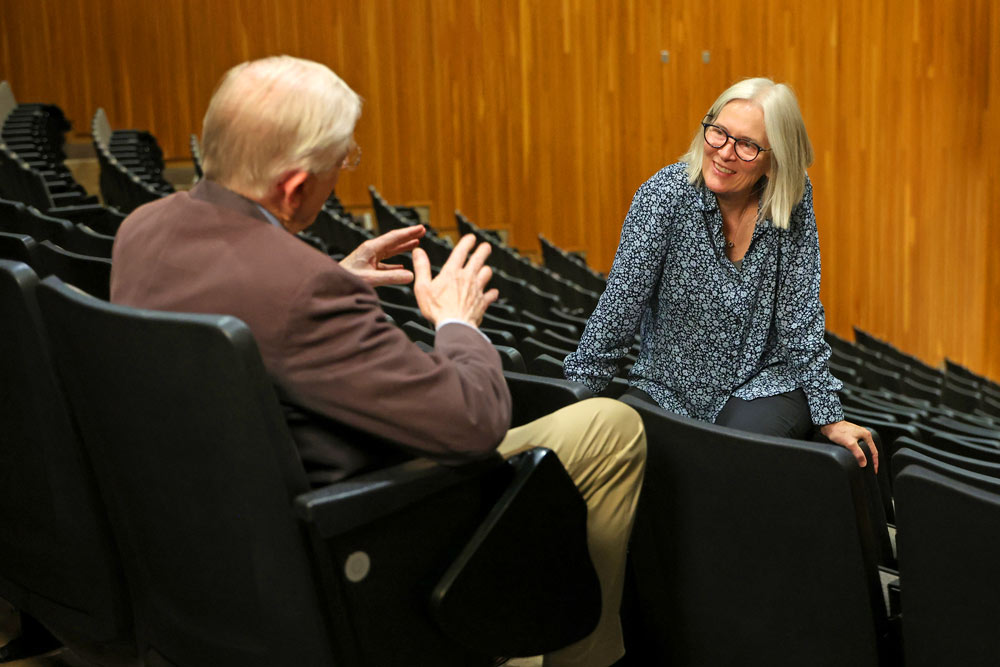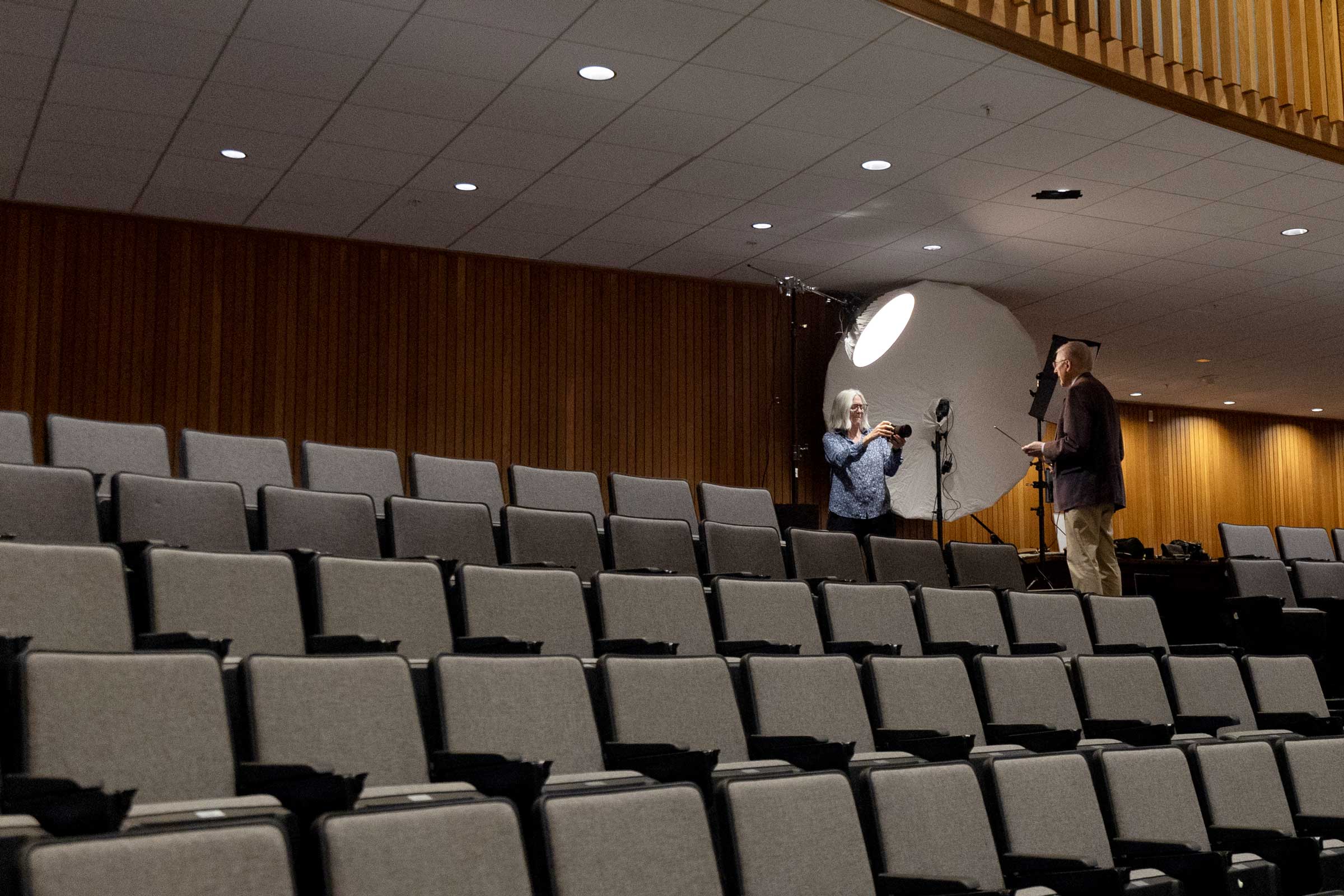She Was Going To Be a Lawyer. Then Ken Elzinga Intervened

Nancy Andrews might have been a lawyer, if Ken Elzinga hadn’t gotten in her way.
Andrews asked her University of Virginia economics professor for a recommendation letter for law school after taking his antitrust policy class, but Elzinga demurred. Not because he didn’t have glowing things to say about her, but because he knew her talents were better suited elsewhere.
“Nancy, the world does not need another lawyer. You are so gifted in photography, you should pursue a career there,” Elzinga, the Robert C. Taylor Professor of Economics, remembered saying.
It was a good call. Andrews would later become a photographer for the Washington Post, win the White House News Photographer of the Year award and have more than 70 photos in the permanent collection of the National Gallery of Art. The University recently commissioned her to take Elzinga's portrait, which it intends to display on Grounds, an honor bestowed upon few members of the University community.
Andrews returned to Grounds earlier this month and saw her former professor for the first time in decades. She was there to take Elzinga’s portrait in the Chemistry Auditorium, where he had taught for years – and where she herself had taken a course.
Finding a ‘Real Job’
Before Andrews would win three Emmy Awards as an editor at the Detroit Free Press or teach photography at West Virginia University, she needed to decide if she wanted to pursue a career in photography.
“Should I have a real job?” Andrews remembered asking herself. “An attorney was a real job, a real thing. It’s something you aspire to. And it just seemed sort of crazy to make a living in photography.”
That was despite the fact she had worked paying photography gigs since high school. The UVA Bookstore even sold a poster of a photo she took of the Rotunda during a summer storm as a bolt of lightning flashed against a deep purple sky over the historic building, titled “Enlightening.”
Elzinga still has that poster hanging in his office. It was one of the reasons he knew Andrews should pursue a career in photography.
In his five decades and counting as a UVA professor, countless students have come to Elzinga’s office hours for advice on what they should do after graduation. Usually, he doesn’t try to push them in any particular direction, just shows them they have a wider “choice set,” to borrow a term from economics, than they might have realized.
“In the case of Nancy, that was pretty easy. She’s gifted in photography,” Elzinga said.

Elzinga had followed Andrews’ career since graduation, but the two hadn’t seen each other since 1986 until she took his photo in May. (Photo by Matt Riley, University Communications)
For Andrews, the answer was less obvious. She came to UVA thinking she would do all the things she couldn’t once she was no longer a student, like joining the Jefferson Literary and Debating Society, being a sister of Alpha Chi Omega and taking photos for the Cavalier Daily.
“When he made that supply and demand argument, that there are a lot of great lawyers and less great photographers … it was pretty convincing,” Andrews said.
After her conversation with Elzinga, and with encouragement from other photographers she knew, Andrews decided to give herself five years to see if she enjoyed life as a professional photographer. She landed an internship at the Free Lance-Star in Fredericksburg, which turned into a full-time job.
“It sort of felt like a scam, to get paid to ride around and take pictures,” Andrews said.
But others saw that it was “real work.” In 1994, HarperCollins published Andrews’ first book, “Family: A Portrait of Gay and Lesbian America.” That summer, the Corcoran Gallery of Art in Washington held an exhibition of the entire work.
Andrews said photos are “memory devices,” and they have helped her remember the people she met throughout her career. She recalled a moment when a fellow photographer at the Washington Post questioned her decision to choose a certain picture of a woman.
“I was naming all these things that were photographer reasons to like the picture, when she goes, ‘But she doesn’t look good, and she’s not going to like it,’” Andrews said. “She really taught me in that moment that it’s not a one-way street. It’s a collaboration.”
Returning to Grounds
Elzinga hadn’t spoken to Andrews in years, but when UVA President Jim Ryan’s office commissioned his portrait and told him he could choose his photographer, he knew who he wanted to ask.
He emailed Andrews and asked if she would be interested in the job. Andrews was running out the door when she saw the email on her phone; she wrote him back to say she would be honored to take his photo.
“It’s just butterflies. I mean, it’s Mr. Elzinga,” Andrews said.
Weeks after those initial emails, she stood in the auditorium where she had taken one of Elzinga’s courses. But this time, it was his job to listen to her.

Andrews photographed Elzinga in the Chemistry Auditorium, where he taught for decades. (Photo by Matt Riley, University Communications)
“I was determined that I was going to let Nancy be the boss,” Elzinga said.
Over a two-day period, Andrews caught up with her old professor and took hundreds of photos of Elzinga in his office – the same place he had that memorable conversation with Andrews – and the classroom he has taught in for decades.
In his office, Elzinga started looking through the records he keeps from all his classes through the years. Along with the old student directories he keeps – it’s easier to find former students contact information that way – were papers showing her midterm grade from Elzinga’s antitrust policy course.
She was touched at how he continued to care about his students even after they left Grounds. Photos were her “memory device,” but the decades-old directories and class files may have been Elzinga’s, she thought.






